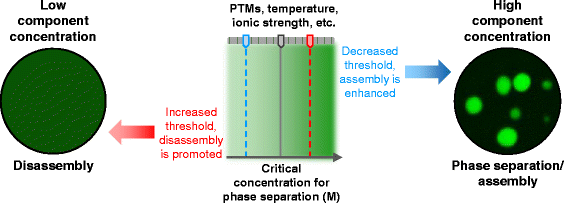Phase separation in biology; functional organization of a higher order
- PMID: 26727894
- PMCID: PMC4700675
- DOI: 10.1186/s12964-015-0125-7
Phase separation in biology; functional organization of a higher order
Abstract
Inside eukaryotic cells, macromolecules are partitioned into membrane-bounded compartments and, within these, some are further organized into non-membrane-bounded structures termed membrane-less organelles. The latter structures are comprised of heterogeneous mixtures of proteins and nucleic acids and assemble through a phase separation phenomenon similar to polymer condensation. Membrane-less organelles are dynamic structures maintained through multivalent interactions that mediate diverse biological processes, many involved in RNA metabolism. They rapidly exchange components with the cellular milieu and their properties are readily altered in response to environmental cues, often implicating membrane-less organelles in responses to stress signaling. In this review, we discuss: (1) the functional roles of membrane-less organelles, (2) unifying structural and mechanistic principles that underlie their assembly and disassembly, and (3) established and emerging methods used in structural investigations of membrane-less organelles.
Figures


Similar articles
-
Methods for Physical Characterization of Phase-Separated Bodies and Membrane-less Organelles.J Mol Biol. 2018 Nov 2;430(23):4773-4805. doi: 10.1016/j.jmb.2018.07.006. Epub 2018 Jul 24. J Mol Biol. 2018. PMID: 30017918 Free PMC article. Review.
-
RNAs, Phase Separation, and Membrane-Less Organelles: Are Post-Transcriptional Modifications Modulating Organelle Dynamics?Bioessays. 2018 Dec;40(12):e1800085. doi: 10.1002/bies.201800085. Epub 2018 Oct 29. Bioessays. 2018. PMID: 30370622 Review.
-
Phase Separation in Asymmetric Cell Division.Biochemistry. 2020 Jan 14;59(1):47-56. doi: 10.1021/acs.biochem.9b00813. Epub 2019 Oct 28. Biochemistry. 2020. PMID: 31617345
-
Macromolecular crowding: chemistry and physics meet biology (Ascona, Switzerland, 10-14 June 2012).Phys Biol. 2013 Aug;10(4):040301. doi: 10.1088/1478-3975/10/4/040301. Epub 2013 Aug 2. Phys Biol. 2013. PMID: 23912807
-
Liquid-liquid phase separation as a common organizing principle of intracellular space and biomembranes providing dynamic adaptive responses.Biochim Biophys Acta Mol Cell Res. 2021 Oct;1868(11):119102. doi: 10.1016/j.bbamcr.2021.119102. Epub 2021 Jul 20. Biochim Biophys Acta Mol Cell Res. 2021. PMID: 34293345 Review.
Cited by
-
Altered Phase Separation and Cellular Impact in C9orf72-Linked ALS/FTD.Front Cell Neurosci. 2021 Apr 21;15:664151. doi: 10.3389/fncel.2021.664151. eCollection 2021. Front Cell Neurosci. 2021. PMID: 33967699 Free PMC article.
-
Could Targeting NPM1c+ Misfolding Be a Promising Strategy for Combating Acute Myeloid Leukemia?Int J Mol Sci. 2024 Jan 9;25(2):811. doi: 10.3390/ijms25020811. Int J Mol Sci. 2024. PMID: 38255885 Free PMC article. Review.
-
Single-molecule FRET unmasks structural subpopulations and crucial molecular events during FUS low-complexity domain phase separation.Nat Commun. 2023 Nov 13;14(1):7331. doi: 10.1038/s41467-023-43225-y. Nat Commun. 2023. PMID: 37957147 Free PMC article.
-
Multiscale Modeling of Protein-RNA Condensation in and Out of Equilibrium.Methods Mol Biol. 2023;2563:117-133. doi: 10.1007/978-1-0716-2663-4_5. Methods Mol Biol. 2023. PMID: 36227470 Free PMC article.
-
Isolating and Analyzing Protein Containing Granules from Cells.Curr Protoc. 2021 Mar;1(3):e35. doi: 10.1002/cpz1.35. Curr Protoc. 2021. PMID: 33740275 Free PMC article.
References
Publication types
MeSH terms
Substances
Grants and funding
LinkOut - more resources
Full Text Sources
Other Literature Sources

